check engine AUDI A8 2013 Owner's Manual
[x] Cancel search | Manufacturer: AUDI, Model Year: 2013, Model line: A8, Model: AUDI A8 2013Pages: 318, PDF Size: 79.34 MB
Page 234 of 318
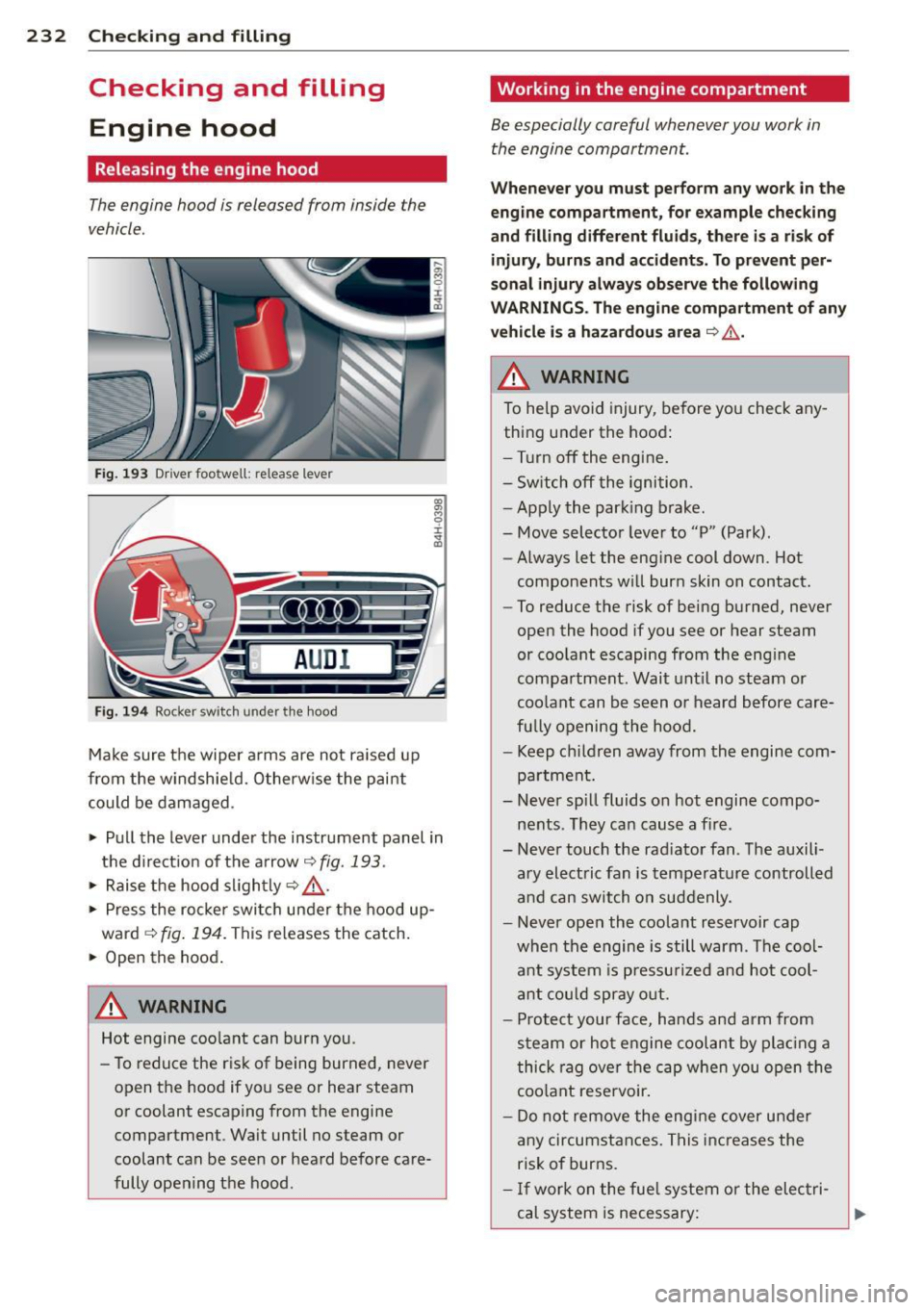
232 Checking and filling
Checking and filling Engine hood
Releasing the engine hood
The engine hood is released from inside the
vehicle .
Fig. 193 Driver foo twell: release lever
AUD I
Fig. 194 Rocker switch un der the hood
Make sure the wiper arms are not raised up
from the windshield. Otherwise the paint
could be damaged .
.,. Pull the lever under the instrument panel in
the direction of the arrow
~ fig. 193.
.,. Raise the hood slightly~,&. .
... Press the rocker switch under the hood up
ward
~ fig. 194. This releases th e catch.
... Open the hood.
&_ WARNING
Hot engine coolant can burn you.
- To reduce the risk of being burned, never
open the hood if you see or hear steam
or coolant escaping from the engine compartment . Wait until no steam or
coolant can be seen or heard before care
fully opening the hood .
' Working in the engine compartment
Be especially careful whenever you work in
the engine compartment.
Whenever you must perform any work in the
engine compartment, for example checking
and filling different fluids, there is a risk of injury, burns and accidents. To prevent per
sonal injury always observe the following
WARNINGS. The engine compartment of any
vehicle is a hazardous area
~ ,&. .
A WARNING
To help avoid injury, before you check any
thing under the hood:
- Turn off the engine.
- Switch off the ignition .
- Apply the parking brake.
- Move selector lever to "P" (Park) .
- Always let the engine cool down. Hot
components will burn skin on contact.
- To reduce the risk of being burned, never
open the hood if you see or hear steam
or coolant escaping from the engine
compartment. Wait until no steam or
coolant can be seen or heard before care
fully opening the hood.
- Keep children away from the engine com
partment.
- Never spill fluids on hot engine compo
nents . They can cause a fire .
- Never touch the radiator fan. The auxili
ary electric fan is temperature controlled
and can switch on suddenly .
- Never open the coolant reservoir cap
when the engine is still warm . The cool
ant system is pressurized and hot cool
ant could spray out.
- Protect your face, hands and arm from
steam or hot engine coolant by placing a
thick rag over the cap when you open the
coolant reservoir.
- Do not remove the engine cover under
any circumstances. This increases the
risk of burns.
- If work on the fuel system or the electri
cal system is necessary:
Page 235 of 318

-Always disconnect the battery.
- Never smoke or work near heaters or open flames. Fluids in the engine com
partment could start a fire.
- Keep an approved fire extinguisher im
mediately available.
- To avoid electrical shock and personal in
jury while the engine is running or being
started, never touch :
- Ignition cables
- Other components of the high voltage
electronic ignition system.
- If you must perform a check or repair
with the engine running:
- First, fully apply the parking brake,
move selector lever to "P" (Park).
- Always use extreme caution to prevent
clothing, jewelry, or long hair from get
ting caught in the radiator fan, V-belts
or other moving parts, or from contact ing hot parts. Tie back hair before
starting, and do not wear clothing that
will hang or droop into the engine.
- Minimize exposure to emission and
chemical ha zards c:::> & .
A WARNING
California Proposition 65 Warning:
- Engine exhaust, some of its constituents,
and certain vehicle components contain
or emit chemicals known to the State of
California to cause cancer and birth de
fects and reproductive harm. In addition ,
certain fluids contained in vehicles and
certain products of component wear con
tain or emit chemicals known to the
State of California to cause cancer and
birth defects or other reproductive harm .
Checking and filling 233
-Battery posts, terminals and related ac
cessories contain lead and lead com
pounds, chemicals known to the State of
California to cause cancer and reproduc
tive harms. Wash hands after handling.
(D Note
When adding fluids, always make sure that
they are poured into the proper container
or filler opening, otherwise serious dam
age to vehicle systems will occur.
(® For the sake of the environment
To detect leaks in time, inspect the vehicle
floor pan from underneath regularly . If
you see spots from oil or other vehicle flu ids, have your vehicle inspected by an au
thorized Audi dealer.
Closing the engine hood
.,. Pull the hood down until the pressure from
the struts is reduced.
"' Let the hood
drop down and latch in place.
Do not try to push it shut; it may fail to en
gage
c:::> ,A .
A WARNING
-
A hood that is not completely latched
could fly up and block your view while driv
ing .
- When you close the engine hood, check it
to make sure the safety catch has proper ly engaged. The hood should be flush
with the surrounding vehicle body parts.
- If you notice while driving that the hood
is not secured properly , stop at once and
close it. •
•
Page 236 of 318
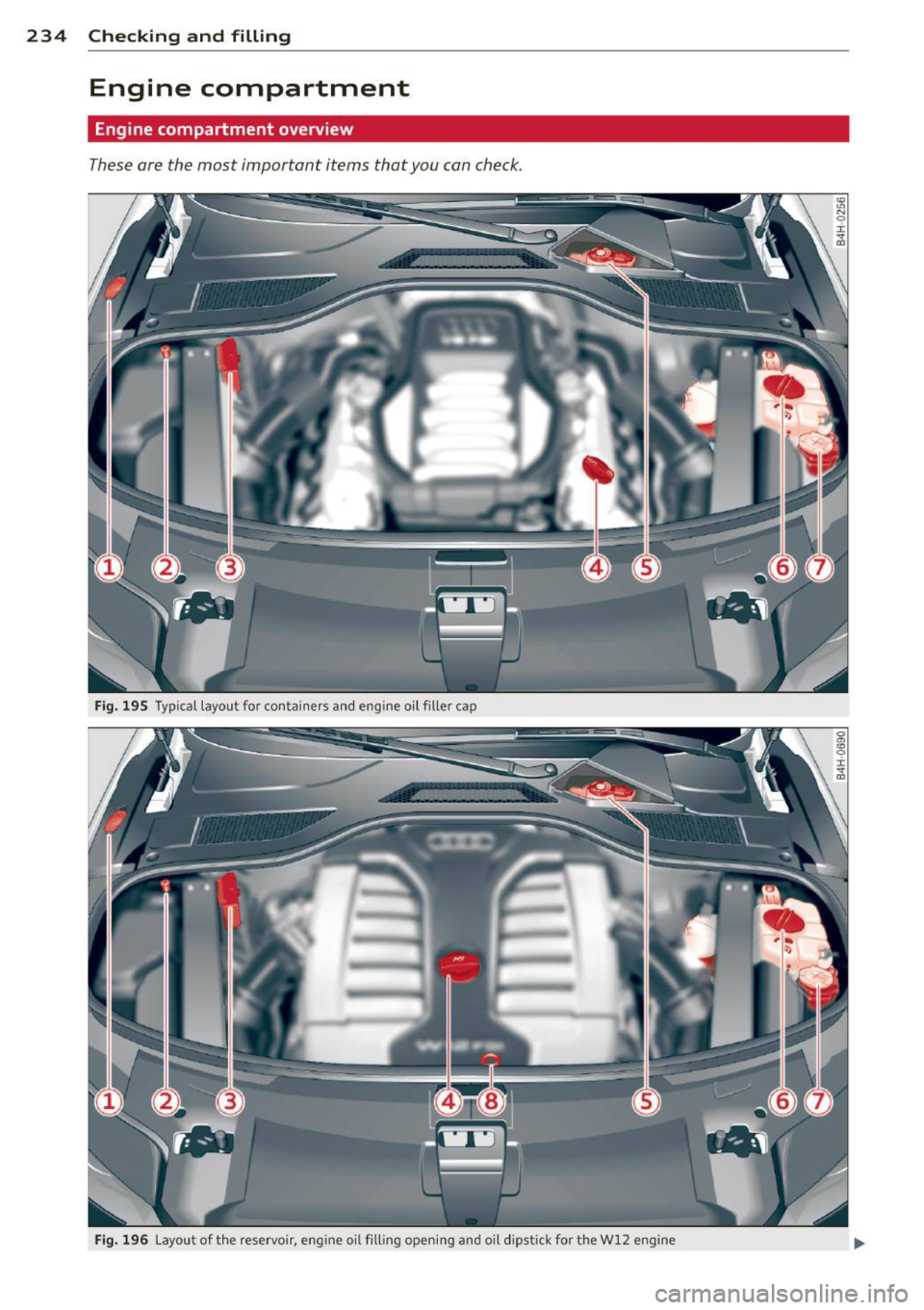
234 Checking and filling
Engine compartment
Engine compartment overview
These are the most important items that you can check.
Fig. 195 Typical layout for co nta iners and eng ine o il filler cap
Fig. 196 Layo ut of th e rese rvo ir, engine o il filling op enin g and o il dipstick for the W l2 eng ine
Page 237 of 318
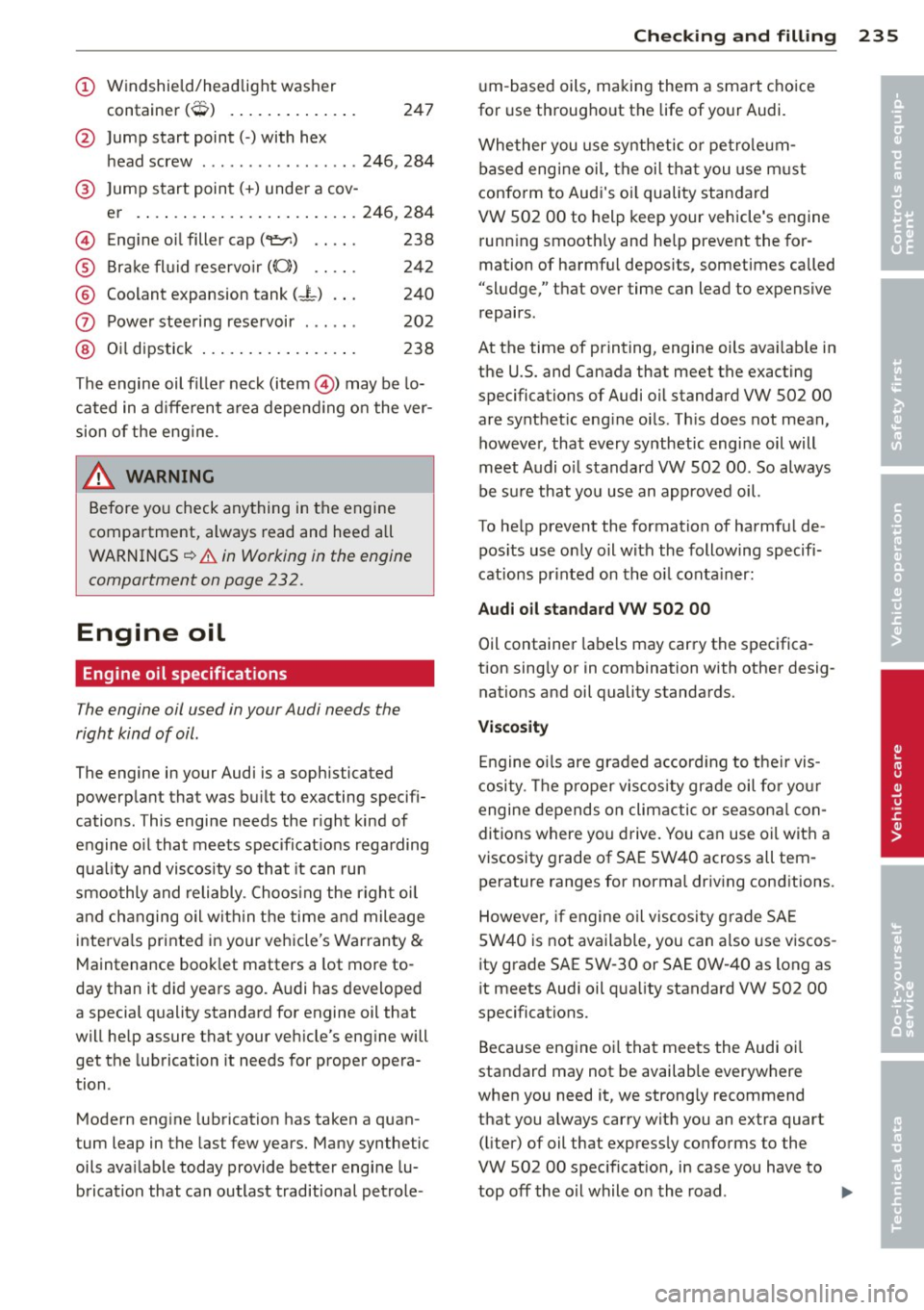
(!) Windshield/headlight washer
t .
(~ ) con ainer ,..., .. .... ... ... . . 247
@ Jump start point( -) with hex
h ead screw ............... .. 246, 284
® Jump start point( +) under a cov-
er . ..... .. ... .. ..... ... .. . 246, 284
@ Engine oil filler cap(~) . . . . . 238
® Brake fl uid reservo ir ((0)) . . . . . 242
® Coolant expansion tank (-L) . . . 240
0 Power steering reservoir . . . . . . 202
@ Oil dipstick . . . . . . . . . . . . . . . . . 238
The engine oil fille r nec k (item @) may be lo
cated in a d ifferent a rea depend ing o n the ver
sion of the eng ine .
A WARNING
Before yo u check any thing in the engine
compartment, always read and heed all
WARNINGS
~ &. in Working in the engine
compartment on page 232.
Engine oil
Engine oil specifications
The engine oil used in your Audi needs the
right kind of oil.
-
The engine in your Audi is a sophisticated
powerp lant that was bu ilt to exacting specifi
cations. This engine needs the r ight kind of
engine o il that meets specificat ions rega rding
qua lity and viscos ity so that it can run
smoothly and reliably . Choos ing the righ t oi l
and ch anging oil with in t he time and mileage
inte rva ls printed in your veh icle's Warranty
&
M aintenance book let matters a lot more to
day than it d id years ago. A udi has developed
a special quality standard for engine oil that
will he lp assure that your veh icle's eng ine will
get the lubrication it needs for prope r opera
tion .
M odern eng ine lubrication has taken a quan
tum leap in the last few years. Many synthetic
oils ava ilable today provide better engine lu
brication that can outlast traditional pet role -
Checkin g and fillin g 235
um -based oils, ma king them a smart cho ice
for use throughout the life of your Audi.
Whether you use sy nthetic o r pe trole um
based eng ine oil, the oil tha t you use m ust
confo rm to Aud i's oi l quality standard
VW 502 00 to help keep your vehicle's engine runn ing smooth ly and he lp prevent the for
mation of harmful deposits, sometimes called
"sludge," that over time can lead to expensive
repairs .
At the time of printing, engine oils ava ilab le in
the U.S. and Canada that meet the exact ing
specifications of Audi oi l standard VW 502 00
are synthet ic eng ine o ils . Th is does not mean,
howeve r, that every sy nthetic engi ne oil will
meet A udi o il standard VW 502 00 . So always
be s ure that yo u use an approved oil.
To he lp prevent the formation of harmfu l de
pos its use on ly o il wi th the following specifi
cat ions pr inted on th e oil conta iner:
Audi oil standard VW 502 00
Oil container labe ls may car ry the specifica
tion sing ly or in combination with othe r desig
nations and oil quality standards.
Viscosity
E ngine o ils are graded a ccord ing to the ir vis
cosi ty . T he p roper viscos ity grade oil fo r yo ur
engine depends on climactic o r seasona l con
ditions where yo u drive. You can use oi l wit h a
viscosity grade of SAE 5W40 across all tem
perature ranges for norma l driv ing cond itions.
However, if engine oil viscosity g rade SA E
5W40 is not available, you can also use viscos
ity grade SAE 5W -30 or SAE OW -40 as long as
it meets Audi oil q ua lity standard VW 502 00
specifications.
Because eng ine o il tha t meets the Audi oi l
standard may not be availab le everywhere
when you need it, we strong ly recommend
that you a lways carry wit h you an extra quart
( li ter) of oil that express ly conforms to the
VW 502 00 spec if icat ion, in case you have to
top off the o il while o n the road . .,..
•
•
Page 238 of 318
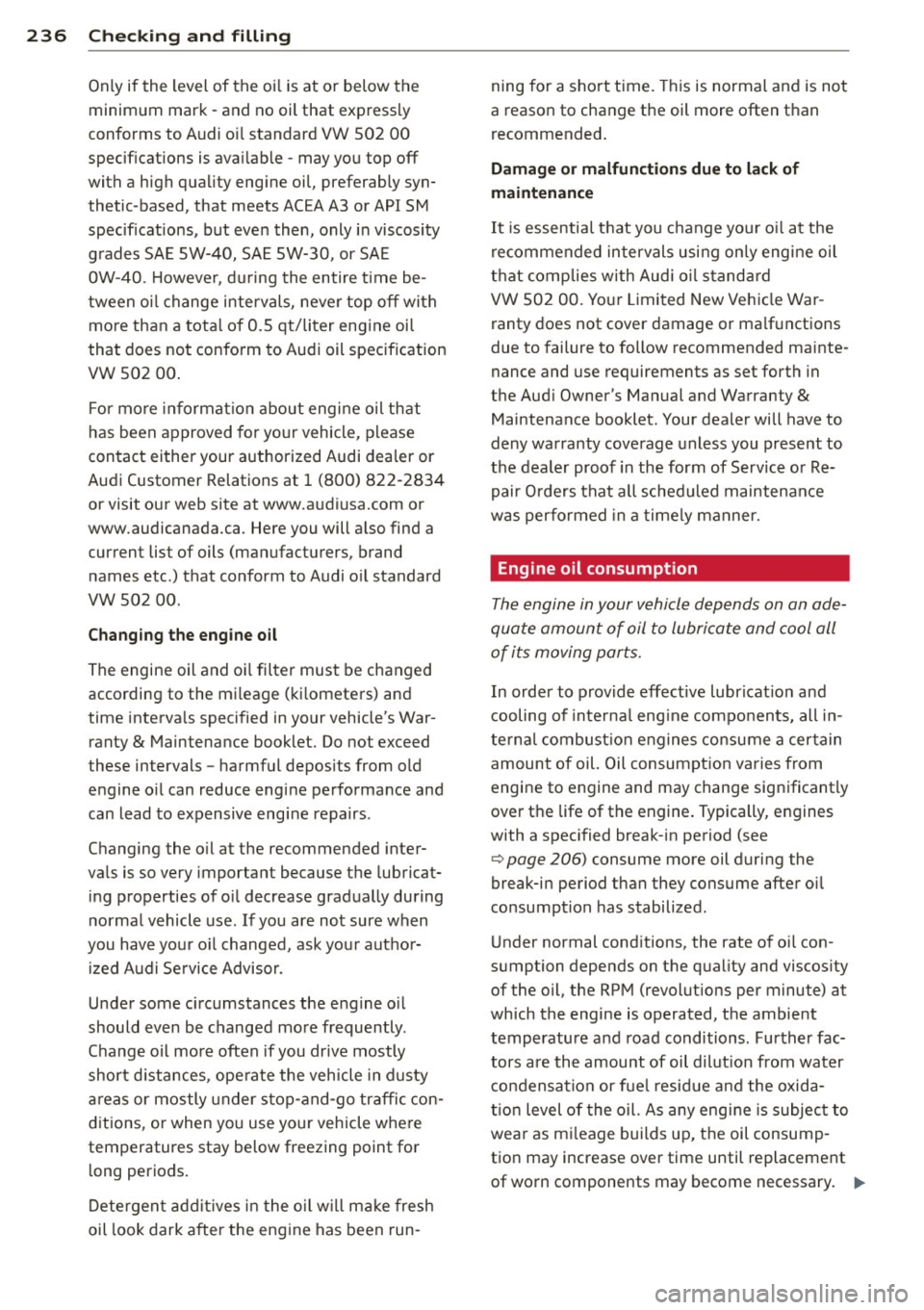
236 Check ing and filling
Only if the level of the oi l is at or below the
minimum mark -and no oil that expressly
conforms to Audi o il standard VW 502 00
specifications is ava ilable - may you top off
with a high quality eng ine oil, preferably syn
thetic -based, that meets AC EA A3 or API SM
specif ications, but even then, only in viscos ity
grad es SAE SW-40, SA E SW-30 , or SAE
OW-40. Howeve r, during the en tire t ime be
tween oi l change intervals, never top off with
more than a tota l of 0.5 qt/liter eng ine oi l
that does not conform to Audi oil specification
vw 502 00 .
F or more informa tion about engine oil that
has been approved for yo ur vehicle , please
contact either your authorized Audi dealer or
Audi Customer Relations at 1 (800) 822-2834
or visit our web site at www.audiusa.com or
www.audicanada.ca . Here you will a lso find a
current list o f oils (manufacturers, brand
names etc .) that conform to Audi o il standard
vw 502 00.
Chang ing the engine oil
The engine oil and oi l filter must be changed
according to the m ileage (ki lometers) and
time interva ls specified in your vehicle's War
ranty
& Maintenance booklet. Do not exceed
these in tervals -harmful depos it s from old
engine o il can reduce engine performance and
can lead to expensive eng ine repairs .
Changing the o il at the recommended inter
va ls is so very important because the lubricat
ing p roperties of o il decrease gradually during
norma l vehicle use. If you are not sure when
you have you r o il changed, ask you r autho r
iz ed Audi Service Advisor.
Under some c ircumstances the engine o il
should even be changed more frequently .
Change oi l mo re often if you drive mostly
short d istances , ope rate the vehicle in dusty
a reas or mostly under s top-and-go tr affic con
d itions , or when yo u use your vehicle whe re
temperatures stay below freezing point for l ong periods .
D etergen t add itives in the o il w ill mak e fresh
oil look dark after the eng ine has been run- ning for a sho
rt time. This is normal and is not
a reason to change the oil more often than
recommended.
Damage or malfunctions due to l ack of
maintenance
It is essentia l th at you c hange yo ur oil at the
r ecommended intervals usi ng on ly eng ine oil
that comp lies with Audi oi l standa rd
VW 502 00. You r Limited New Vehicle War
r anty does not cover damage or ma lf u nctions
due to failure to follow recommended ma inte
nance and use requirements as set forth in
the Aud i Owner's Manual and Warranty
&
Maintenance booklet. Your dealer will have to
deny warranty coverage unless you present to
the dealer proof in the form of Service o r Re
pair Orders that all scheduled maintenan ce
w as performed in a time ly m anner.
Engine oil consumption
The engine in your vehicle depends on an ade
quate amount of oil to lubri cate and
cool all
of its moving por ts .
In order to p rovide effective lubricat ion and
c ooling of inte rna l eng ine compo nents, all i n
tern al combust ion engines co nsume a cer tain
amount of oil. Oil consumpt ion varies from
engine to engine and may change significantly
over the life of the engine . Typically , engines
with a spec ified break-in period (see
¢ page 206) consume more oil duri ng the
break-i n period than they consume after o il
consumption has stabilized .
Under normal cond itions , the rate of oi l con
s u mption depends on the q uality and viscos ity
of the oil, the RPM (revolut ions per minu te) at
which the engine is operated, the ambient
temperature and road conditions. Further fac
tors a re the amount of oil dilut ion from water
c o ndensa tion or fue l resid ue a nd the oxida -
t ion level of the oil. As any engine is subjec t to
wea r as m ileage b uilds up, the oil consump-
tion may increase over time until replacement of wo rn components may become necessary. ..,..
Page 239 of 318
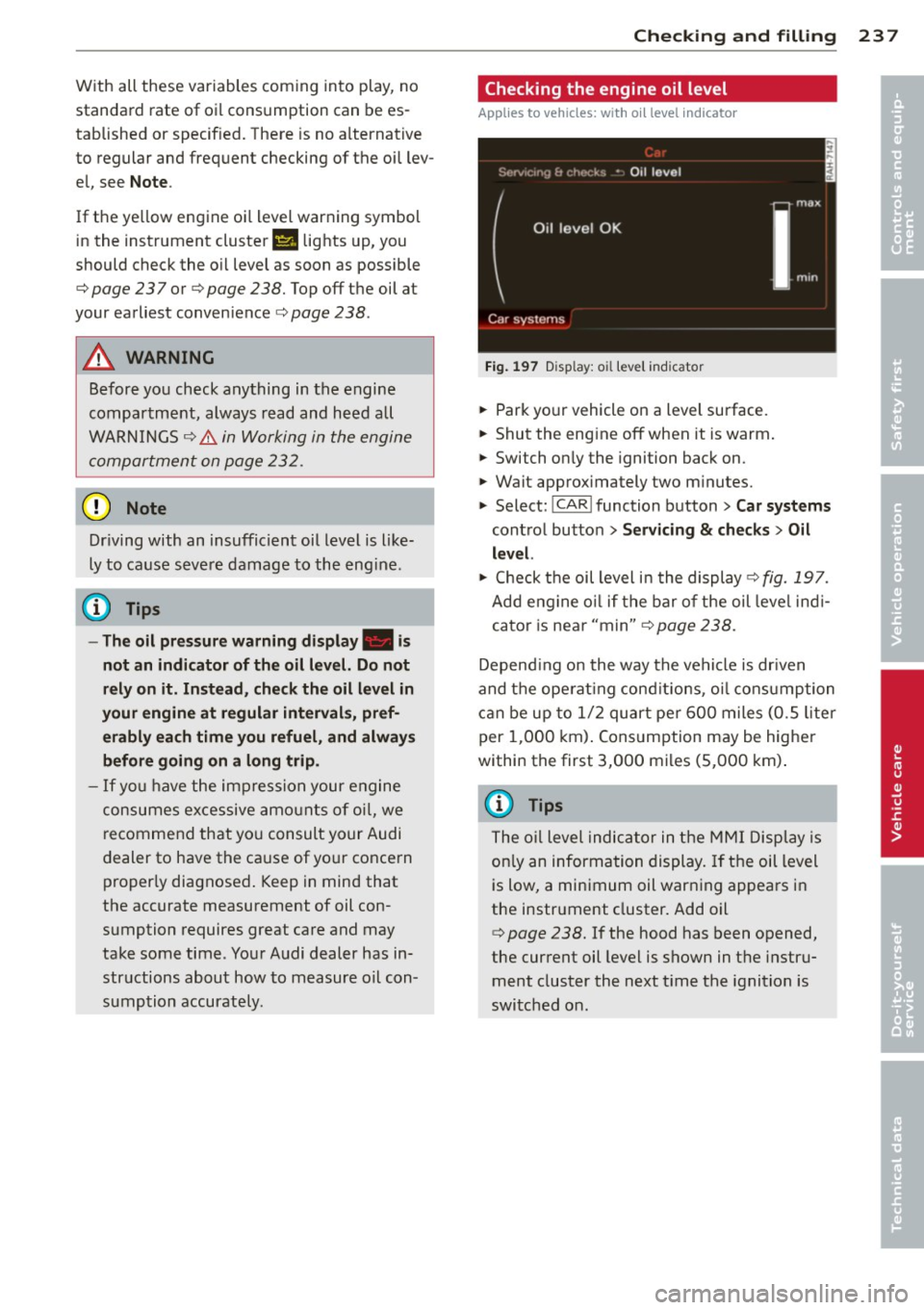
With all these variables coming into play, no
standard rate of oil consumption can be es
tablished or specified . There is no alternative
to regular and freq uent checking of the oi l lev
e l, see
Note .
If the ye llow engine oi l level war ning symbol
in the instrument cluster
II lights up, you
should check the o il level as soon as possible
¢
page 23 7 or ¢ page 238. Top off the oil at
your earliest convenience¢
page 238 .
.&_ WARNING
Before yo u check anything in the engine
compartment, always read and heed all
WARN INGS
¢ &. in Working in the engine
compartment on page 232.
0 Note
Dr iving with an insufficient oil level is like
ly to ca use seve re damage to the eng ine.
{1) Tips
- The oil pressu re warning display. i s
not an indicator of the oi l level. Do not
rely on it. Instead , check th e oil level in
your engine at regular interval s, pref
erably each time you refuel, and always before going on a long trip .
-If yo u have the impres sion your engine
consumes excessive amo unts o f oil, we
r ecommend that yo u consult your Audi
dealer to have the ca use of yo ur conce rn
proper ly diagnosed . Keep in mind that
the accurate measurement of oil con
sumption requires great care and may
take some time. You r Audi dealer has in
str uctions about how to measure o il con
sumption accurately.
Checkin g and fillin g 237
Checking the engine oil level
Applies to vehicles : wit h oil level indicator
Fi g. 1 97 Disp lay: o il leve l indicator
.,. Park yo ur vehicle on a level surface.
.,. Shut the eng ine off when it is warm .
.,. Switch on ly the ignition back on .
.,. Wait approx imately two m inutes.
.,. Select:
I CAR ! function button > Car systems
contro l butto n > Servicing & checks > Oil
level.
.,. Check t he oil level i n the display ¢ fig. 197.
Add eng ine o il if t he bar o f the oil leve l ind i
cator is near "min"¢
page 238.
Depend ing on the way the vehicle is dr iven
and t he ope rat ing cond it ions, oi l cons umption
c a n be up to 1/ 2 quart pe r 60 0 miles (0.S liter
per 1,000 km) . Cons umption may be higher
within the first 3,000 m iles (S,000 km) .
(D Tips
The o il leve l indic ato r in the MMI Disp lay is
on ly an informa tion display.
If t h e oil level
i s low, a minimum oil warn ing appears in
the instrument cluster. Add oil
¢
page 238. If the hood has been opened,
the current oil level is shown in t he instr u
ment cluster the next t ime the ignition is
swi tched on.
•
•
Page 240 of 318
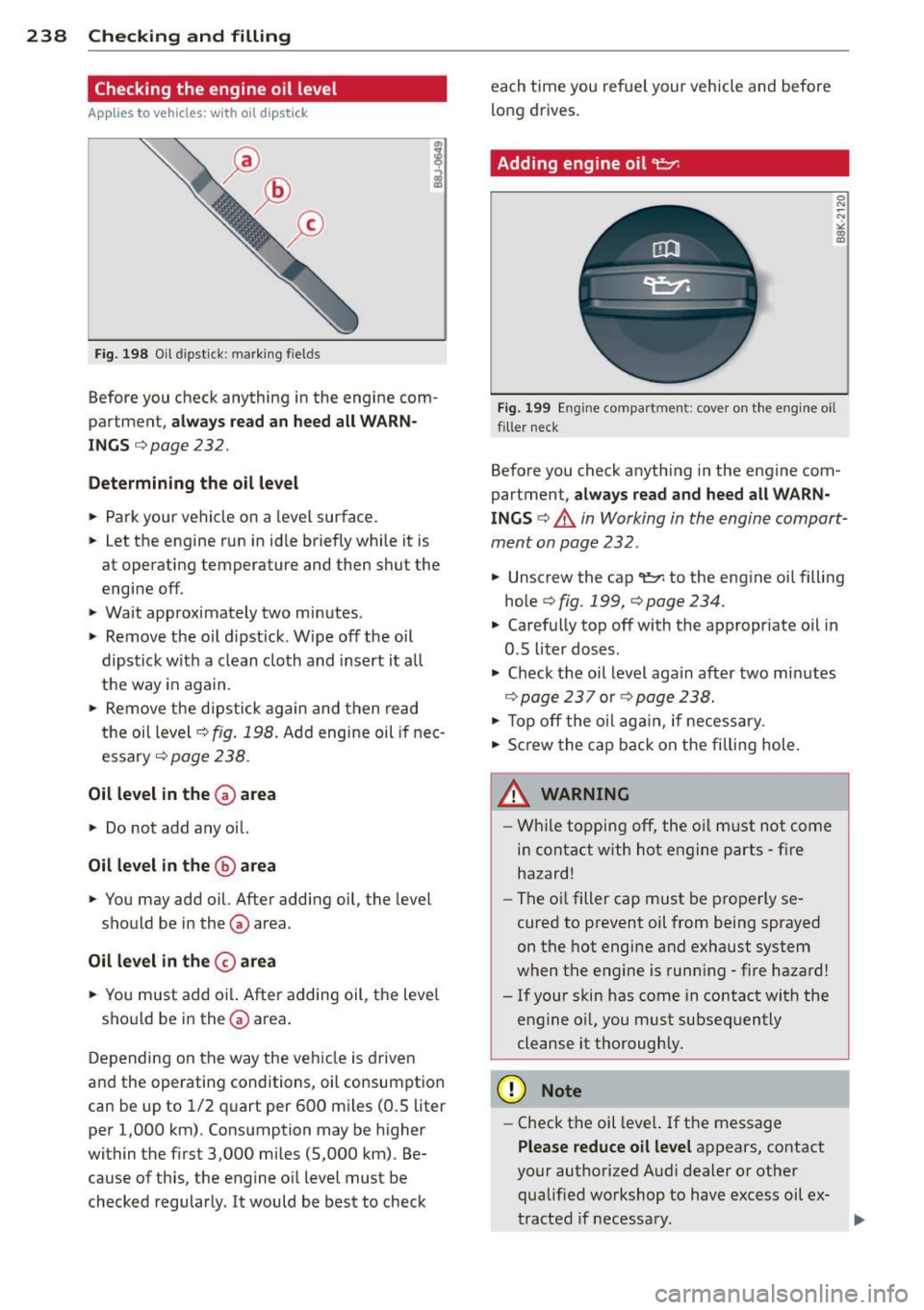
238 Checking and filling
Checking the engine oil level
App lies to vehicles: with oi l dipst ick
Fig. 198 Oil dipsti ck: marking fields
Before you check anything in the engine com
partment,
always read an heed all WARN
INGS c::;,page 232.
Determining the oil le vel
.. Park your vehicle on a leve l surface .
.. Let the engine run in id le b riefly while it is
at operating temperature and then shut the
engi ne off.
.. Wait approximately two min utes .
.. Remove the oil d ipst ick . W ipe off the oil
dip stic k w it h a clean cloth a nd insert i t all
t h e way in aga in .
.. Remove the dipstick again and t hen read
t h e oi l level
¢ fig . 198. Add engine oil if nec
essary
¢ page 238.
Oil level in the~ area
.. Do not a dd any oi l.
Oil level in the @area
.. You may add oil. After adding oil, the level
shou ld be i n the
G) area.
Oil level in the 0 area
.. You must add o il. Afte r adding oil, t he leve l
sho uld be in the
G) area .
D epending on the way the vehicle is drive n
a nd the operating conditions, oil consumpt ion
can be up to 1/2 q uart per 600 mi les (0.5 liter
per 1 ,000 km) . Cons umption may be higher
wit hin the f irst 3,000 mi les (5,000 km) . Be
cause of th is, t he engine o il level must be
checked regularly . It would be best to check each time you ref
ue l your vehicle and before
lo ng d rives .
Adding engine oil~
0 N ,.
"' 0:, m
Fig. 199 En g in e co mpa rtm ent : cove r on th e eng in e o il
f il le r neck
Befo re you check anyth ing in the engine com
partment,
always read and heed all WARN
INGS c::;, A in Working in the engine compart
ment on page 232 .
.. Unscrew the cap "l!:ir. to the eng ine oi l filling
hole
c::;, fig . 199, c::;, page 234 .
.. Carefully top off with t he appropr iate oil in
0 .5 li ter doses.
.. Check the oil level again after two minut es
c::;, page 237 or ¢ page 238 .
.. Top off the o il agai n, if neces sary.
.. Scr ew the ca p ba ck on the fi lling hole.
A WARNING
- W hil e to ppin g off, the o il m ust not co me
i n contact with hot en gine parts -fir e
hazard!
- Th e o il filler cap must be pr ope rl y se
cured to p revent oil from being sprayed
on the hot engi ne and e xhaust system
when t he engine is runn ing -fire haza rd !
- If you r skin has come in contact wit h the
e ng ine o il, you must subseq uently
cleanse it thor oughly.
(D Note
- Check the oil leve l. If the message
Please reduce oil level appears, contact
yo ur authorized A ud i d ealer or othe r
qualified worksh op to have excess oil ex-
t ract ed if necessa ry. .,,_
Page 241 of 318
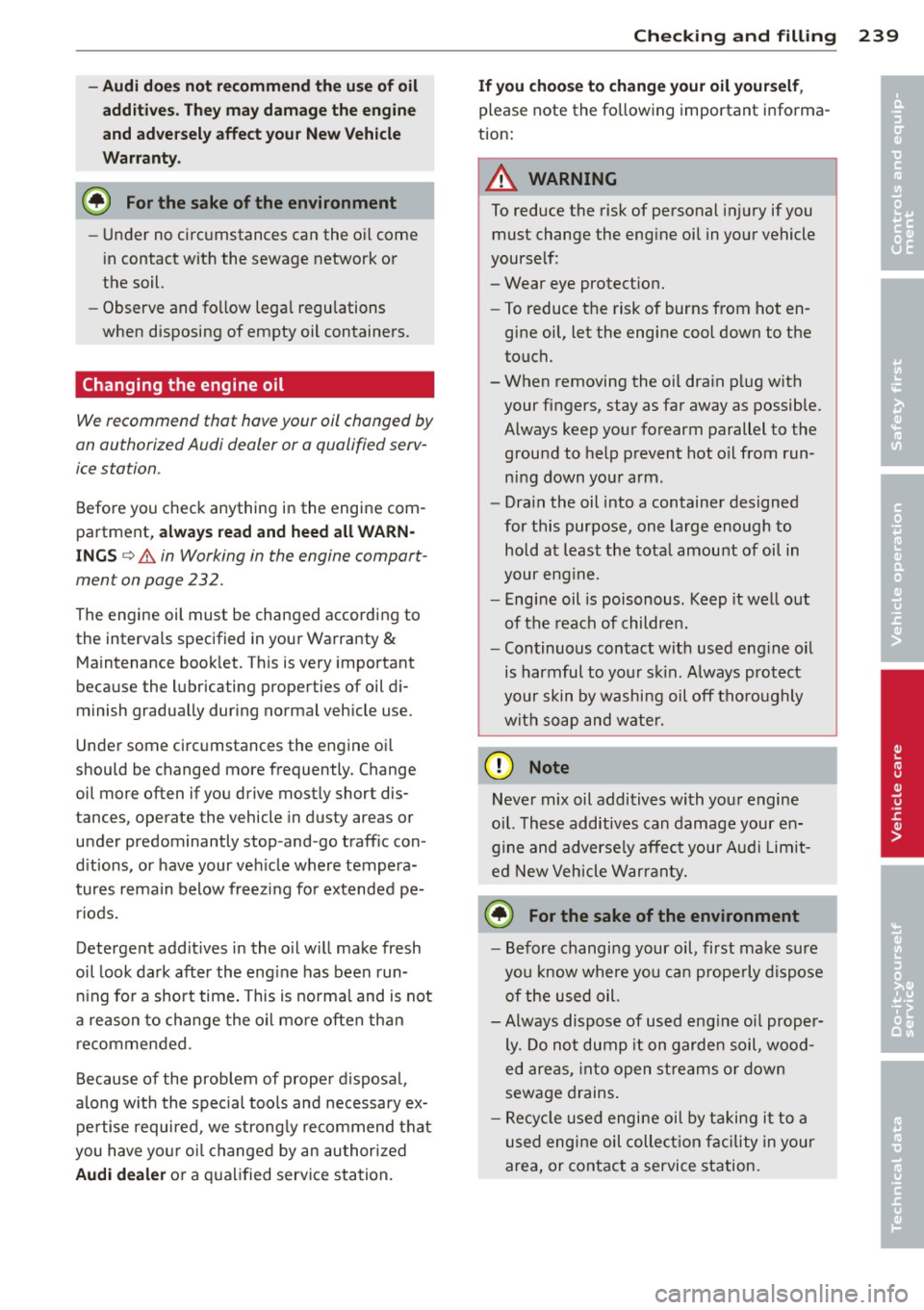
-Audi doe s not recommend the use of oil
add iti ve s. T he y ma y damage the engine
and ad ve rse ly affect you r New Vehicle
Wa rrant y.
@ For the sake of the environment
- Under no circumstances can the oil come
in contact with the sewage network or
the soil.
- Observe and follow lega l regu lations
when disposing of empty oil containers.
Changing the engine oil
We recommend that hove your oil changed by
on authorized Audi dealer or a qualified serv
ice station .
Before you check anything in the engine com
partment,
a lw ays r ead and heed all WARN
ING S
c:> &. in Working in the engine comport
ment on page 232.
The engine oil must be changed according to
the intervals specified in your Warranty
&
Maintenance booklet. This is very important
because the lubricating properties of oil di
minish gradually dur ing normal veh icle use.
Under some circumstances the engine oil
should be changed more frequently. Change
oil more often if you drive mostly short dis
tances, operate the vehicle in dusty areas or
under predominantly stop-and -go traff ic con
d itions, or have your veh icle where tempera
tures remain below freezing fo r extended pe
r iods.
Detergent additives in the o il w ill make fresh
oil look dark after the eng ine has been run
n ing fo r a short time. This is norma l and is not
a reason to change the oi l mo re often than
recommended.
Because of the problem of proper disposal,
along w ith the special tools and necessary ex
pe rtise required, we strong ly recommend that
you have your oi l changed by an author ized
A udi dealer or a qualified service station.
Checkin g and fillin g 239
If yo u choose to change you r oil yo urs elf ,
please note the fo llowing important informa
tion:
_& WARNING
To reduce the risk of personal injury if you
must change the engine oil in your vehicle
yourself:
- Wear eye protect ion.
- To reduce the risk of burns from hot en-
gine oil, let the engine cool down to the
touch.
- When removing the oi l dra in p lug with
your fingers, stay as far away as possible.
Always keep your forearm parallel to the
grou nd to help prevent hot o il from run
ning down you r arm.
- Dra in the oil into a container designed
for this purpose, one large enough to hold at least the tota l amount of oil in
your engine.
- Engine oil is poisonous. Keep it well o ut
of the reach of children.
- Continuous contact with used eng ine o il
is harmful to yo ur skin . A lways protect
your skin by washing oil off tho roughly
w it h soap and w ater.
d) Note
N eve r mix oil additives with your engine
oil. These additives can damage your en
g ine and adversely affect your Audi Lim it
ed New Vehicle Warranty.
@ For the sake of the environment
- Before changi ng your oil, first make sure
you know where you ca n prope rly dispose
of the used oil.
- Always dispose of used eng ine oi l proper
ly. Do not dump it on garde n soil, wood
ed areas, into open streams or down
sewage drains .
- Recycle u sed engi ne oil by taking it to a
used eng ine oil colle ct ion facility in your
area, or contact a service station.
•
•
Page 242 of 318
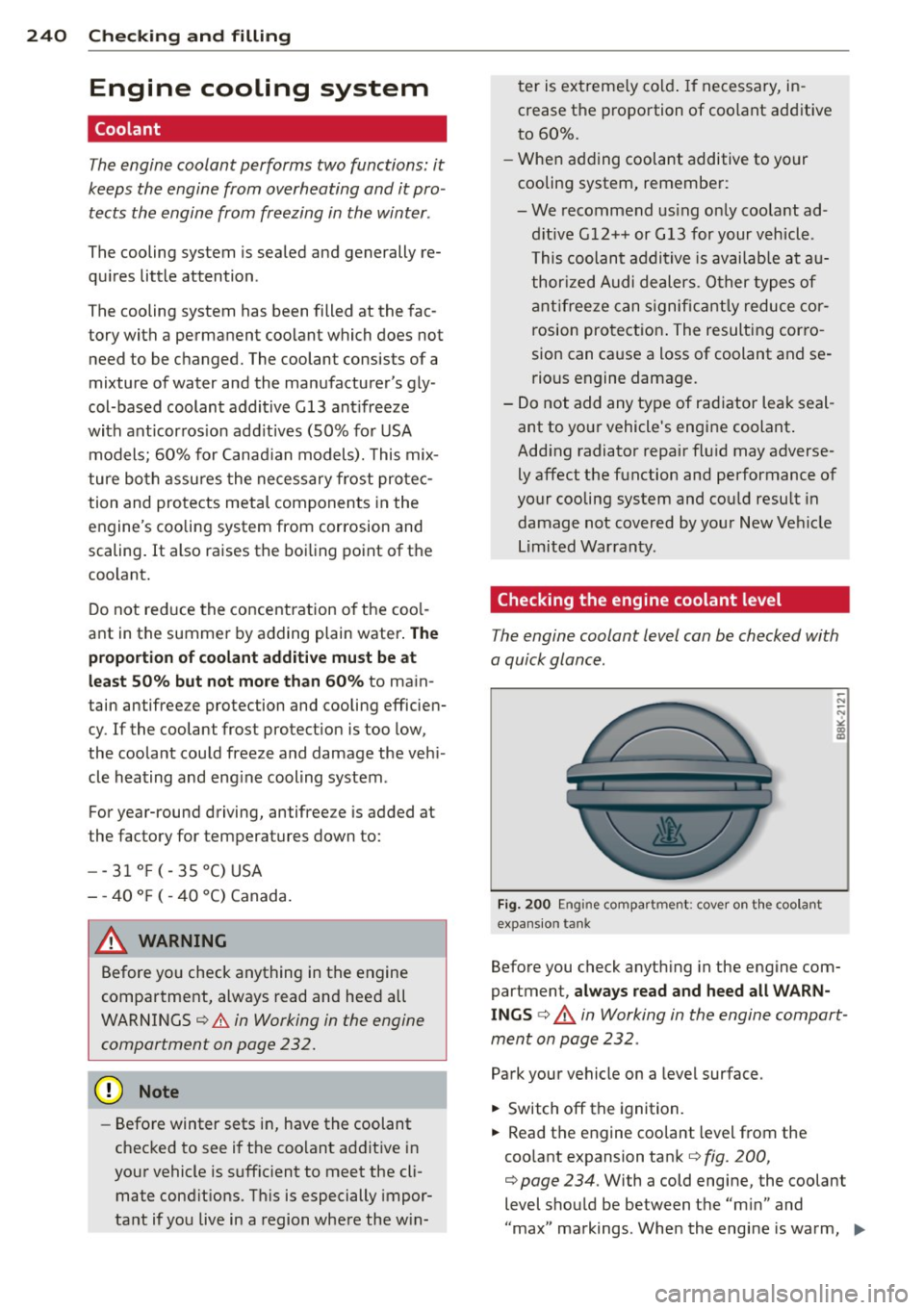
240 Checking and filling
Engine cooling system
Coolant
The engine coolant performs two functions: it
keeps the engine from overheating and it pro
tects the engine from freezing in the winter .
The cooling system is sealed and generally re
quires little attention.
The cooling system has been filled at the fac
tory with a permanent coolant which does not need to be changed. The coolant consists of a
mixture of water and the manufacturer's gly
col-based coolant additive Gl3 ant ifreeze
with anticorros ion add itives (50% for USA
models; 60% for Canadian models). This mix
ture both assures the necessary frost protec
tion and protects metal components in the
engine's cooling system from corrosion and
scaling. It also raises the boiling point of the
coolant.
Do not reduce the concentration of the coo l
ant in the summer by adding plain water .
The
proportion of coolant additive must be at
least 50% but not more than 60%
to main
tain antifree ze protection and cooling efficien
cy. If the coolant frost protection is too low,
the coolant could freeze and damage the veh i
cle heating and engine cooling system .
For year-round driving, antifree ze is added at
the factory for temperatures down to:
- -31°F(-35°C)USA
- - 40 °F ( - 40 °C) Canada.
A WARNING
Before you check anything in the engine
compartment, always read and heed all
WARNINGS
c:> &. in Working in the engine
compartment on page 232.
- Before winter sets in, have the coolant
checked to see if the coolant additive in
your vehicle is sufficient to meet the cli
mate conditions. This is especially impor
tant if you live in a region where the w in- ter
is extreme ly cold . If necessary, in
crease the proportion of coolant additive
to 60%.
- When adding coolant additive to your
cooling system, remember:
- We recommend using only coolant ad
ditive Gl2++ or Gl3 for your vehicle .
This coolant additive is available at au
thorized Audi dealers. Other types of
antifreeze can significantly reduce cor
rosion protection. The resulting corro
sion can ca use a loss of coolant and se
rious engine damage.
- Do not add any type of radiator leak seal
ant to your vehicle's engine coolant .
Add ing radiator repair fluid may adverse
ly affect the function and performance of
your cooling system and could result in
damage not covered by your New Vehicle
Limited Warranty.
Checking the engine coolant level
The engine coolant level can be checked with
a quick glance .
Fig. 200 Engin e compar tmen t: cover on t he coolant
expansio n ta nk
Before you check anything in the engine com
partment,
always read and heed all WARN
INGS c:> &. in Working in the engine compart
ment on page 232 .
Park your vehicle on a level surface .
.,. Switch off the ignition.
.,. Read the engine coolant level from the
coo lant expansion tank
c:> fig. 200,
c:> page 234. With a cold engine, the coolant
level should be between the "min" and
"max" markings. When the engine is warm, ..,
Page 243 of 318
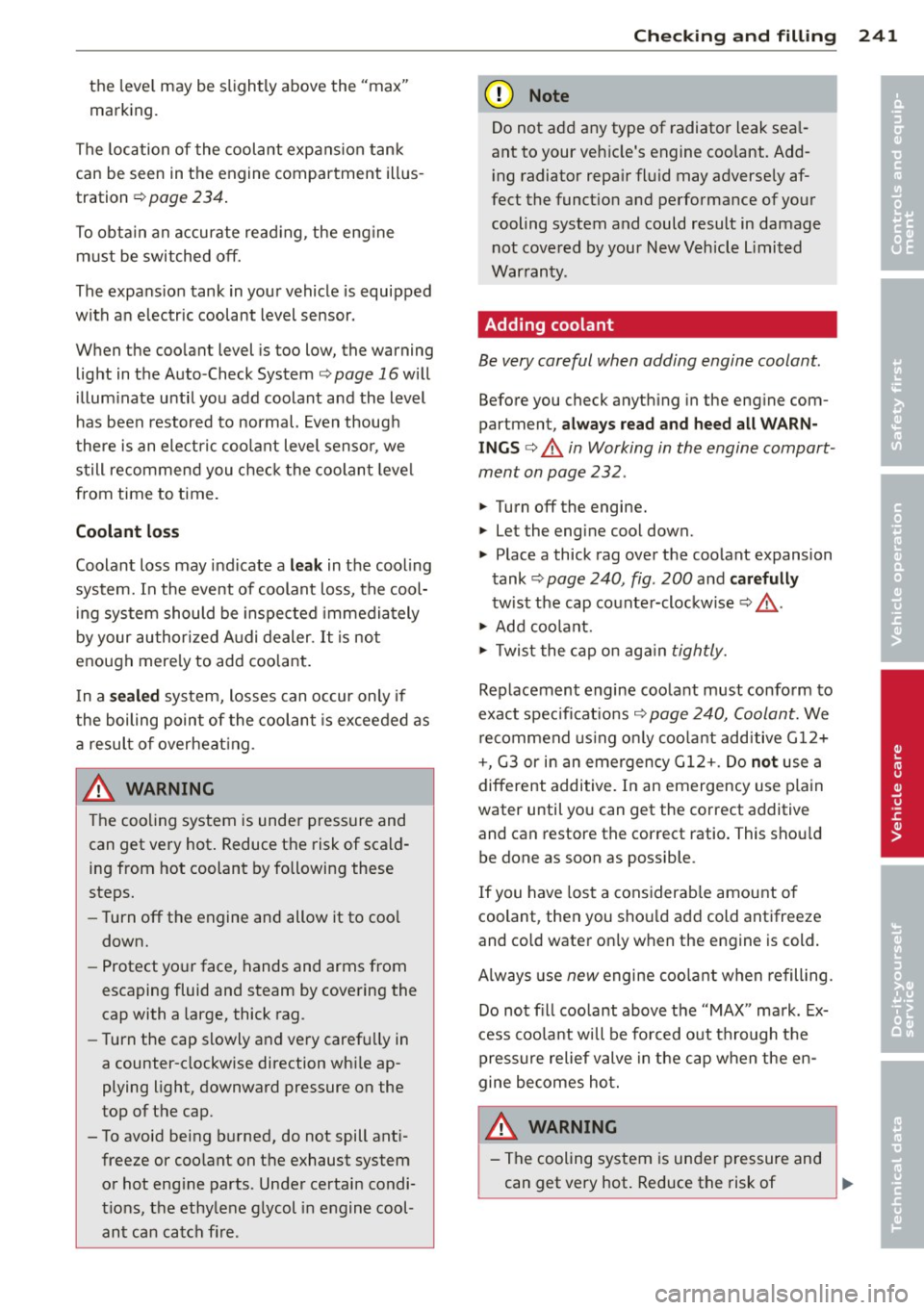
the level may be slightly above the "max"
marking .
The location of the coolant expansion tank
can be seen in the engine compartment illus
tration ¢
page 234.
To obtain an accurate reading, the engine
must be switched
off.
The expansion tank in your vehicle is equipped
with an electric coolant level sensor.
When the coolant level is too low, the warning
light in the Auto-Check System
¢page 16will
illuminate until you add coolant and the level
has been restored to normal. Even though
there is an electric coolant level sensor , we
still recommend you check the coolant level
from time to time.
Coolant loss
Coolant loss may indicate a leak in the cooling
system. In the event of coolant loss, the cool
ing system should be inspected immediately
by your authorized Audi dealer.
It is not
enough merely to add coolant.
In a
sealed system, losses can occur only if
the boiling point of the coolant is exceeded as
a result of overheating.
& WARNING
The cooling system is under pressure and
can get very hot. Reduce the risk of scald
ing from hot coolant by following these
steps.
- Turn
off the engine and allow it to cool
down.
- Protect your face, hands and arms from
escaping fluid and steam by covering the
cap with a large, thick rag.
- Turn the cap slowly and very carefully in
a counter-clockwise direction while ap
plying light, downward pressure on the
top of the cap.
- To avoid being burned, do not spill anti freeze or coolant on the exhaust system or hot engine parts . Under certain condi
tions, the ethylene glycol in engine cool
ant can catch fire .
Checking and filling 241
@ Note
Do not add any type of radiator leak seal
ant to your vehicle's engine coolant. Add
ing radiator repair fluid may adversely af
fect the function and performance of your
cooling system and could result in damage not covered by your New Vehicle limited
Warranty .
Adding coolant
Be very careful when adding engine coolant.
Before you check anything in the engine com
partment,
always read and heed all WARN
INGS ¢ & in Working in the engine compart
ment on page 232 .
.,. Turn off the engine .
.,. let the engine cool down.
.,. Place a thick rag over the coolant expansion
tank ¢
page 240, fig . 200 and carefully
twist the cap counter-clockwise ¢&_ .
.,. Add coolant.
.,. Twist the cap on again
tightly.
Replacement engine coolant must conform to
exact specifications ¢
page 240, Coolant. We
recommend using only coolant additive G12+
+, G3 or in an emergency G12+. Do
not use a
different additive. In an emergency use plain
water until you can get the correct additive
and can restore the correct ratio. This should
be done as soon as possible.
If you have lost a considerable amount of
coolant , then you should add cold antifreeze
and cold water only when the engine is cold.
Always use
new engine coolant when refilling.
Do not fill coolant above the "MAX" mark. Ex
cess coolant will be forced out through the pressure relief valve in the cap when the en
gine becomes hot.
A WARNING
- The cooling system is under pressure and
can get very hot. Reduce the risk of
II-
•
•